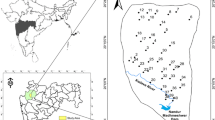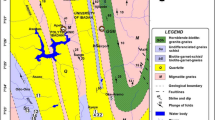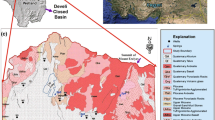Abstract
Geochemical, heavy metals (HMs) distribution, and environmental health treat due to cadmium (Cd), copper (Cu), iron (Fe), nickel (Ni), lead (Pb), and zinc (Zn) had been studied within the groundwater of Asad Abad, Hamedan, Iran. The order and average percentage (meq l−1) of cations and anions has been: Ca2+ (49.3) > Mg2+ (32.3) > Na+ (17.9) > K+ (0.5) and \({\text{HCO}}_{3}^{ - }\) (62.7) > Cl− (28.0) > > SO42− (6.2) > \({\text{NO}}_{3}^{ - }\) (3.1). The principal water types were: Ca-HCO3, Mg-HCO3, and Na-HCO3. In contrast to the background concentration (3.4 mg l−1) and threshold (13 mg l−1) of \({\text{NO}}_{3}^{ - }\), 45 and 40 percentage of water samples confirmed higher concentrations, respectively. The mean concentration (μg l−1) of Cd, Cu, Fe, Ni, Pb and Zn has been 117.2, 29.3, 136.0, 91.9, 48.4 and 5.8, respectively, and as a consequence, the order of HMs was Fe > Cd > Ni > Pb > Cu > Zn. Heavy metals which include Cd, Pb and Ni (37%) of water samples exceeded permissible levels, while Cu, Fe (96.5%) and Zn had been observed to be inside permissible limits. Contamination factor calculated for all HMs confirmed that contamination in water samples varies mostly from low to mild contamination. Based on sum of the percentage of each HM in class 2, 3 and 4 (moderate, considerable and very high degree of contamination, respectively), the contribution of every HM in contamination degree turned into calculate and the order was: Pb (100%) > Zn (93%) > Cu (71%) > Fe (64%) > Cd (53%) > Ni (43%). The outcomes indicated that Cd posed a capability non-carcinogenic health risk to consumers in all sampling sites.











Similar content being viewed by others
References
Abdalla F, Khalil R (2018) Potential effects of groundwater and surface water contamination in an urban area, Qus City, Upper Egypt. J Afr Earth Sci 141:164–178
Al-Saleh I, Al-Doush I (1998) Survey of trace elements in household and bottled drinking water samples collected in Riyadh, Saudi Arabia. Sci Total Environ 216:181–192
Arain MB, Kazi TG, Baig JA, Jamali MK (2009) Respiratory effects in people exposed to arsenic via the drinking water and tobacco smoking in southern part of Pakistan. Sci Total Environ 407:5524–5530
ATSDR (Agency for Toxic Substances and Disease Registry) (2015) Toxicologial profiles, toxic substances portal. Available at: http://www.atsdr.cdc.gov/toxprofiles/index.asp. Accessed Nov 2015
Bawaskar HS, Bawaskar PH, Bawaskar PH (2010) Chronic renal failure associated with heavy metal contamination of drinking water: a clinical report from a small village in Maharashtra. Clin Toxicol 48:768
Bhutiani R, Kulkarni DB, Khanna DR, Gautam A (2017) Geochemical distribution and environmental risk assessment of heavy metals in groundwater of an industrial area and its surroundings, Haridwar, India. Energy Ecol Environ 2:155–167
Burkart MR, Kolpin DW (1993) Hydrologic and land use factors associated with herbicides and nitrates in near-surface aquifers. J Environ Qual 22:646–656
Debieche TH (2002) Evolution of water quality (salinity, nitrogen and heavy metals) under the effect of saline, agricultural and industrial pollution: application to the low plain of seybouse North-East Algeria. Ph.D. Dissertation. Besançon, France: University of Franche-Comt_[in French]
Demirak A, Yilmaz F, Tuna AL, Ozdemir N (2006) Heavy metals in water, sediment and tissues of Leuciscus cephalus from a stream in southwestern Turkey. Chemosphere 63:1451–1458
Goldhaber SB (2003) Trace element risk assessment: essentiality vs. toxicity. Regul Toxicol Pharm 38:232–242
Hakanson L (1980) An ecological risk index for aquatic pollution control. A sedimentological approach. Water Res 14:975–1001
Hooda PS, Alloway BJ (1994) Sorption of Cd and Pb by selected temperate and semi-arid soils: effects of sludge application and ageing of sludge soils. Water Air Soil Pollut 74:235–250
IARC (International Agency for Research on Cancer) (2016) IARC monographs on the evaluation of carcinogenic risks to humans. Volumes 1-115. Available at: http://monographs.iarc.fr/ENG/Classification/latest_classif.php. Accessed on 12 April 2016
Jalali M (2005) Nitrates leaching from agricultural land in Hamadan, western Iran. Agric Ecosyst Environ 110:210–218
Jalali M (2007) Phosphorous status and sorption characteristics of some calcareous soils of Hamadan, western Iran. Environ Geol 53:365–374
Jalali M (2009) Phosphorous concentration, solubility and species in the groundwater in a semi-arid basin, southern Malayer, western Iran. Environ Geol 57:1011–1020
Jalali M, Arfania H (2010) Leaching of heavy metals and nutrients from calcareous sandy loam soil receiving municipal solid sewage sludge. J Plant Nutr Soil Sci 173:407–416
Jalali M, Jalali M (2016) Geochemistry and background concentration of major ions in spring waters in a high-mountain area of the Hamedan (Iran). J Geochem Explor 165:49–61
Jalali M, Jalali M (2017) Assessment risk of phosphorus leaching from calcareous soils using soil test phosphorus. Chemosphere 171:106–117
Jalali M, Jalili A (2011) Competitive adsorption of trace elements in calcareous soils as affected by sewage sludge, poultry manure, and municipal waste compost. Environ Earth Sci 63:731–739
Jalali M, Khanlari ZV (2006) Mobility and distribution of zinc, cadmium and lead in calcareous soils receiving spiked sewage sludge. Soil Sediment Contam 15:603–620
Jalali M, Latifi Z (2018) Measuring and simulating effect of organic residues on the transport of cadmium, nickel, and zinc in a calcareous soil. J Geochem Explor 184:372–380
Khanlari ZV, Jalali M (2008) Concentrations and chemical speciation of five heavy metals (Zn, Cd, Ni, Cu, and Pb) in selected agricultural calcareous soils of Hamadan Province, western Iran. Arch Agron Soil Sci 54:19–32
Khdary NHM, Gassim AEH (2014) The distribution and accretion of some heavy metals in Makkah Wells. J Water Resour Prot 6:998–1010
Marschner H, Rimmington G (1988) Mineral nutrition of higher plants. Plant Cell Environ 11:147–148
Merkel BJ, Planer-Friedrich B (2002) In: Nordstrom DK (ed) Ground-water geochemistry: a practical guide to modeling of natural and contaminated aquatic systems. Springer, Berlin
Monakhov S, Esina O, Monakhova G, Tatarnikov V. 2015. Environmental quality assessment: geoenvironmental indices. In: Armon RH, Hanninen O (eds) Environmental indicators. Springer, Dordrecht. https://doi.org/10.1007/978-94-017-9499-2. ISBN 973-94-017-9498-5
Munoz O, Zamorano P, Garcia O, Bastías JM (2017) Arsenic, cadmium, mercury, sodium, and potassium concentrations in common foods and estimated daily intake of the population in Valdivia (Chile) using a total diet study. Food Chem Toxical 109:1125–1134
Naghipour D, Ashrafi SD, Taghavi K (2018) Data of heavy metals in soil and groundwater at Kiwi gardens of Amlash in Guilan Province, Iran. Data Brief 18:1556–1561
Phan K, Phan S, Huoy L, Suy B, Wong MH, Hashim JH, Yasin MSM, Aljunid SM, Sthiannopkao S, Kim K-W (2013) Assessing mixed trace elements in groundwater and their health risk of residents living in the Mekong river basin of Cambodia. Environ Pollut 182:111–119
Pignotti E, Dinelli E, Birke M (2017) Geochemical characterization and rare earth elements anomalies in surface- and groundwaters of the Romagna area (Italy). Rend Fis Acc Lincei 28:265–279
Planquart P, Bonin G, Prone A, Massiani C (1999) Distribution, movement and plant availability of trace metals in soils amended with sewage sludge compost: application to low metal loadings. Sci Total Environ 241:161–179
Qiang Z, Speir TW, van Schaik AP (2004) Leaching of nutrients from soil cores treated with a single large dose of digested sewage sludge. Biol Fertil Soils 40:284–289
Rezaei A, Hassani H, Hayati M, Jabbari N, Baezegar R (2018) Risk assessment and ranking of heavy metals concentration in Iran’s Rayen groundwater basin using linear assignment method. Stoch Environ Res Risk Assess 32:1317–1336
Rout TK, Masto RE, Ram LC, George J, Padhy PK (2013) Assessment of human health risks from heavy metals in outdoor dust samples in a coal mining area. Environ Geochem Health 35:347–56
Rowell DL (1994) Soil science: methods and applications. Longman Group, Harlow
Schirado T, Vergara I, Schalscha EB, Pratt PF (1986) Evidence for movement of heavy metals in a soil irrigated with untreated wastewater. J Environ Qual 15:9–12
Siebe CH (1995) Heavy metal availability to plants in soils irrigated with wastewater from Mexico City. Water Sci Technol 32:29–34
Tay CK, Hayford E (2016) Levels, source determination and health implications of trace metals in groundwater within the Lower Pra Basin, Ghana. Environ Earth Sci 75:1236
Thambavani SD, Uma Mageswari UTSR (2013) Metal pollution assessment in ground water. Bull Environ Pharmacol Life Sci. 2, 122–129. ISSN 2277-1808
United States Environmental Protection Agency (USEPA) USEPA (2000) Risk-based concentration table (Washington, DC)
USEPA (1992) National Water Inventory. Report to US Congress
USEPA (U.S. Environmental Protection Agency), (2014) USEPA Integrated Risk Information System (IRIS) online database
WHO (2011) Guidelines for drinking water quality. World Health Organization. http://www.doc88.com/p-333730829736.html
Zereg S, Boudoukha A, Benaabidate L (2018) Impacts of natural conditions and anthropogenic activities on groundwater quality in Tebessa plain, Algeria. Sustain Environ Res (in press)
Author information
Authors and Affiliations
Corresponding author
Additional information
Publisher's Note
Springer Nature remains neutral with regard to jurisdictional claims in published maps and institutional affiliations.
Rights and permissions
About this article
Cite this article
Jalali, M., Ghanbari, M. & Jalali, M. Geochemical and environmental health threat evaluation of heavy metals in groundwater of Asad Abad, Hamedan, Iran. Environ Earth Sci 78, 699 (2019). https://doi.org/10.1007/s12665-019-8704-3
Received:
Accepted:
Published:
DOI: https://doi.org/10.1007/s12665-019-8704-3




